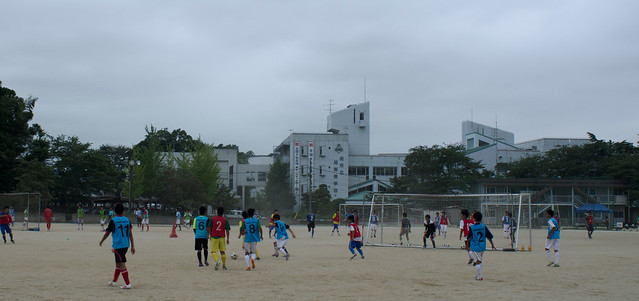We have been in a bit of a crunch at work. I've even had to cancel my gym membership because I haven't had time to go. This will mark the first time since before compulsory PE at Biola that I will be without a membership to any sort of fitness center.
Then again, 先生 would say it would all work out. That is if he ever said anything other than "you're doing it wrong."
That being neither here nor there, what you need to know is that I found out that I was now taking 書道 and am somehow running the English Conversation Club
1± "into the ground."
1, all while managing to fall behind in my writing for TSCA despite starting my article two weeks ago. I just haven't had the time to vet the information. Or make it interesting. Or readable.But, hey, I did just get "The Very Best of Daryl Hall & John Oates
2Remastered.
2." Oh yeah, I'm back on the Yacht Rock!Anyway, so what to write about? Especially if I've spent the last 19 consecutive days at Ichikashi…

Every couple of days you'll see them walking to or from 北柏駅, replete in traditional Japanese clothing with a bow in tow, slung across their back in a leather case like a pool cue or a fishing rod. For the longest time I had no clue who they were, what they were doing, or why they were doing it in or around Kita-Kashiwa. That is until I figured out that the giant building on the other side of Teganuma was the 柏立中央 Gymnasium: one of the biggest municipal gyms in Kashiwa city.
When Ken and I checked it out in June, we were told that they had daily basketball leagues, two or three halls of semi-competitive (to highly-competitive) ping pong tables, three dojos (for judo, kendo and/or karate), a sumo stable that housed children's sumo lessons on the weekends, and a competition-size kyudo range.
Kyudo. Of course.
胴造り. 引分け. 会. 離れ. 残心.
Actually, in all, there are eight formal steps to 弓道 (kyudo), traditional Japanese archery. Each of the eight steps, from the initial placing of the foot (足踏み)--breathe in, breathe out--to the readying (弓構え) and raising (打起し) of the bow--breathe in, breathe out--to the final release, is deliberate and drawn. And despite it's inherent violence, there is a remarkable peace that covers the 弓道場 like a thick woolen blanket. Silent but for the twang of the long, uneven wooden bow and the hiss of the arrow and breath of the archer.
Even though the sharp cries of kendo peeled across the empty lot, carried into the open-air hall on the soft, early autumn breeze, it was hard to ignore the sacredness of the space radiating with a thoughtfulness that, like light splashing into the humid dark of the night air, cascaded out onto the soft grass range below. It felt wrong to move or speak. It even felt invasive to be there to watch.
Though standard ranges, from hall to 的場 (target house), can span up to 60m, the length of the range at 柏立中央体育館, we were told, was just about 28m, or what is termed a "short" matoba. As it was, the archers we had the privilege of watching were struggling with 10- and 20-kilogram 弓, bows that seemed "just right" for a range of under 30m.
"構いません," we were told. "It does not matter."
 |
Photo illicitly obtained from benoist via Flickr. |
As it is with all of the 武道 sports, there is as much emphasis placed on moral and spiritual development as there is on physical accomplishment and mastery. In fact, the first words of explanation out of 先生's mouth were all about the spiritual components of 弓道. Well, that's what Matthew told me. Of everything he said, I understood no more than 6 words. One of them was "かまいません."
Kyudo, we were told, was as much stoic, contemplative meditation-in-action as it was the violent launch of missiles. Actually, the loosing of the arrow from the bow seemed mildly incidental to the entire process. Rather, from the moment the archer places his foot, to the motionless, thoughtful moments after the arrow has rattled itself deep into the 巻藁 bale, the archer is in a still, silent pursuit of the Platonic ideal of 真善美 (shin-zen-bi): truth, goodness and beauty.
To put it simply, the pursuit of shin-zen-bi is the embodiment of the endeavor for and application of truth. Though circumstances and situations are variable, though wind and light may change what the eye sees, when one can see the absolute truth of things as they are, the archer is unperturbed (冴え, さえ: clarity). Practice must then be conducted in trust and faith in the rightness of truth. From that honest pursuit necessarily results in good action, lest the revelation be meaningless. Goodness is this wholehearted intention (誠, まこと: sincerity) of seeking the rightness of action once truth has been revealed. These actions that stem from the solid roots of truth give blossom to the flower of beauty, which is the spiritual goal not just in kyudo, but in all things in the life of the archer (平常心, へいじょうしん: one's presence of mind).
Whether the arrow hits the target is of no matter, 先生 intoned. After all, 正射正中 (せいしゃせいちゅう): correct shooting is correct hitting. "A spirit settled," the Shaho-Kun says, "becomes a harmonious unit."
This is the ideal, from 足踏み to 残心, or the returning to the body from the state of spirit concentration.
Of course that's easy to say when every arrow you loose manages to hit the minuscule 36cm wide target.
Scott ended up cancelling his membership to the Y also... Kyūdō seems like a good fit for you. We have a master of kyūdō (and calligraphy and lots of other stuff) in Little Tokyo, Hirokazu Kosaka at the JACCC. He's interesting to read (http://www.kcet.org/socal/departures/landofsunshine/arrival-stories/from-a-buddhist-monastery-in-japan-to-an-art-legend-in-la.html) and hear (http://www.youtube.com/watch?v=w9r2Qpgp-Ec)...
ReplyDelete